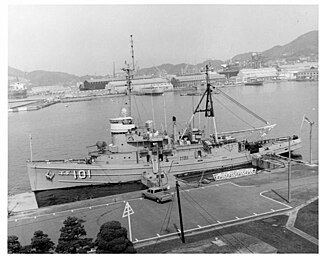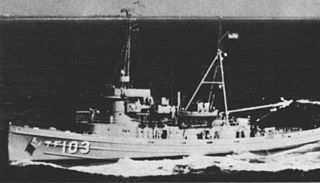
USS Cree (AT/ATF-84), a Cherokee-class fleet tug, was a ship of the United States Navy named for the Cree, an indigenous people of North America whose people range from the Rocky Mountains to the Atlantic Ocean.

USS Quapaw (ATF–110/AT-110) was a Abnaki-class fleet ocean tug in the United States Navy. She was named after the Quapaw.

USS Jason (AR-8) was the fourth of the Vulcan class repair ship of the United States Navy in service from 1944 to 1995, serving in World War II, Korea, Vietnam, and the Gulf War. At the time of her decommissioning, Jason was the oldest ship in continual commission in the United States Navy, and the final ship in continual commission from World War II onward.

USS Clarion River was an LSM(R)-401-class medium-type landing ship (LSM) built for the United States Navy during World War II. Named for the Clarion River in west central Pennsylvania, she was the only US Naval vessel to bear the name.
USS Mataco (AT-86/ATF-86) was a Navajo-class fleet tug constructed for the United States Navy during World War II. Her purpose was to aid ships, usually by towing, on the high seas or in combat or post-combat areas, plus "other duties as assigned." She served in the Pacific Ocean and was awarded five battle stars for World War II, four battle stars for the Korean War, and seven campaign stars for Vietnam War service.

USS Castor (AKS-1) was a Castor-class general stores issue ship commissioned by the U.S. Navy for service in World War II. She was responsible for delivering and disbursing goods and equipment to locations in the war zone.

USS Grapple (ARS-7) is a Diver-class rescue and salvage ship commissioned in the United States Navy from 1943 to 1946 and from 1951 to 1977. In 1977, she was sold to Taiwan and was renamed ROCS Da Hu (ARS-552).
USS Deliver (ARS-23) was a Diver-class rescue and salvage ship commissioned by the U.S. Navy during World War II. Her task was to come to the aid of stricken vessels.

USS Safeguard (ARS-25) was a Diver-class rescue and salvage ship in service with the United States Navy from 1944 to 1947 and from 1952 to 1979. She was then transferred to Turkey where she served as TCG Işın (A-589) until 2017.
USS Valve (ARS-28) was a Diver-class rescue and salvage ship commissioned by the U.S. Navy during World War II. Her task was to come to the aid of stricken vessels.

USS Bolster (ARS-38) was a Bolster-class rescue and salvage ship acquired by the U.S. Navy during World War II and remained in service during the Korean War and the Vietnam War. Her task was to come to the aid of stricken vessels.

USS Aludra (AF-55) was an Alstede-class stores ship acquired by the U.S. Navy. Her task was to carry stores, refrigerated items, and equipment to ships in the fleet, and to remote stations and staging areas.

USS Tombigbee (AOG-11) was a Patapsco-class gasoline tanker in service with the United States Navy from 1943 to 1972. She was then sold to Greece, where she served as Ariadni (A414) until 2003.

USS Apache (AT-67/ATF-67) was a Navajo-class fleet tug, later fleet ocean tug, in commission in the United States Navy from 1942 to 1946 and from 1951 to 1974. She saw service in World War II, the Korean War, and the Vietnam War.

The third USS Tillamook (ATA-192), originally USS ATA-192, a United States Navy tug in service from 1945 to 1971.

USS Cocopa (ATF-101) was an Abnaki-class fleet ocean tug that served on active duty with the U.S. Navy from 1944 to 1978, seeing action in World War II, the Korean War and the Vietnam War. After thirty-four years of service, she was sold to the Mexican Navy, where she was still in service as of 2009.

USS Molala (AT-106/ATF-106) was a US Navy Abnaki-class tugboat, named after the Molala people of Oregon.

USS Moctobi (ATF-105) was an Abnaki-class of fleet ocean tug. She served in World War II, Vietnam, and Korea, the last two of which she received battle stars. She was scrapped in 2012.

USS Hitchiti (ATF-103) was Abnaki-class tugboat during the World War II, Korea and Vietnam. The ship was later sold to Mexico as ARM Chac (R-55). Her namesake is a tribe of Creek Indians who lived in Florida and Georgia. The word "Hitchiti" means "to look up the stream."

USS Shakori (ATF-162) is an Abnaki-class tugboat that saw service during the World War II and Cold War. She was later sold to Republic of China as ROCS Da Tai (ATF-563). Her namesake was a small Indian tribe which originally inhabited an area near the present site of Durham, North Carolina.
This page is based on this
Wikipedia article Text is available under the
CC BY-SA 4.0 license; additional terms may apply.
Images, videos and audio are available under their respective licenses.


















